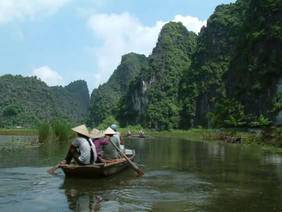Ninh Binh Province: a Promising Ecotourism Destination

The scenic province of Ninh Binh, located just over 100km south of Hanoi, will soon be a popular choice among many visitors coming to Vietnam. Cradling the Day River, the Van Sang River, the Non Nuoc and Canh Dieu Mountains, which along with other several other mountains, plains, rivers, and seas in the region, has created strangely attractive landscapes that captivates the nature-lovers and intrigues those with little touch to nature.
Historic Sites, each with a Story to Tell Aside from the panoramic views, Ninh Binh is also known for the first imperial capital of Vietnam, from 968 to 1010 under Dinh, Le and Ly dynasties. Several well-preserved pagodas and grottos dating back from these dynasties are also among the country’s crucial tourist destination. Among which is the Tam Coc-Bich Dong, grandiose complex of
Bich Dong pagoda and Tam Coc grotto. Bich Dong is a beautiful pagoda on the nearby Ngu Nhac Mountain dating back from the Le Dynasty and is comprised of three structures: Ha, Trung, and Thuong Pagodas. Tam Coc, 3 kilometers from Van Lam Wharf, consists of 3 caves (Hang Ca, Hang Hai, and Hang Ba) and has the reputation for being mysterious and charming.
Hoa Lu, the capital of Vietnam from 968 until 1010, is a recommended first stop when coming to the province. Tourists come here to acquaint themselves with the historical and mysterious world of an ancient capital with miraculous palace, mighty citadel, hiding in the grandiose mountain ranges and gentle Hoang Long rivers. Another must-visit is the
King Dinh Tien Hoang’s Temple located in Truong Yen village, Truong Yen commune, Hoa Lu town, in a garden of 5 hectares wide. Built in the 17th century and with a special architecture, the temply contain several gates before arriving to the main house. Here, visitors can find a stone dragon-bed, which is 1.8m long and 1.4m wide. The temple’s architectural work is laden with folk sculptures depicting the meaningful history of the first ancient capital of Vietnam. Catholic tourists are urged to visit the
Phat Diem Cathedral which was built between 1875 and 1899. Aside from its four roofs and six sets of iron wooden pillars, the structure consists of a network of ponds, lakes, churches, and artificial caves, altogether creating a cool atmosphere and classical religious atmosphere.
Ecotourism at its Best The country’s first and largest National Park, the Cuc Phuong National Park, is also found in Ninh Binh province. The area is considered as one of the most important sites for biodiversity within Vietnam and is home to hundreds of species of flora and fauna. The park is home to 97 species of mammals, most notable are the endangered langurs; 300 species of birds; 36 reptilian species; 17 species of amphibians; 11 species of fish; 2,000 species of vascular plants, and thousands of species of insects, most of whom do not bite. A number of species living in the park are listed on Vietnam Red Book of endangered species. A rewarding activity for visitors include an exploration of Cuc Phuong's many limestone caves including the Thang Khuyet Cave, Con Moong Cave, Pho Ma Cave, and Nguoi Xua Cave and the Cave of Prehistoric Man (Dong Nguoi Xua). The area also has a Botanical Garden ideal for strolling an appreciating the variety of flora found in the region.
Huge Tourism Potential Ninh Binh Province was never really a tourist destination in the past. Today, it is gaining grounds and is slowly receiving the attention it deserves. With the ecological riches it holds, the potential for ecotourism in the province in enormous.









